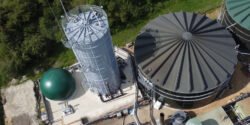Nanofiltration for PFAS
Nanofiltration for PFAS: A Comprehensive Guide
Introduction
Per- and polyfluoroalkyl substances (PFAS) have emerged as a significant public health concern. As more scientific studies unveil the extensive contamination of water supplies by these “forever chemicals,” the urgency for effective water treatment solutions has never been greater. In this context, nanofiltration (NF) presents a promising option for the removal of PFAS from drinking water.
As a senior environmental engineer with years of experience in water treatment technologies, I cannot stress enough the importance of comprehensively understanding PFAS contamination and the innovative solutions available to mitigate its impact. This article dives into the intricacies of nanofiltration, exploring its mechanisms, effectiveness for PFAS treatment, regulatory landscape, and operational considerations, aiming to equip water treatment professionals with concrete knowledge and actionable insights.
Understanding the Landscape of PFAS
What Are PFAS?
PFAS, often referred to as “forever chemicals,” encompass a vast group of synthetic compounds used in applications ranging from firefighting foam to non-stick cookware. Their chemical stability and persistence in the environment make them incredibly challenging to remove through conventional water treatment processes. According to the U.S. Environmental Protection Agency (EPA), certain PFAS compounds have been linked to various health issues, including immune system dysfunction and increased cancer risk.
The Regulatory Environment
As of 2025, regulatory scrutiny on PFAS has intensified, with the EPA proposing enforceable drinking water standards for several PFAS compounds. Additionally, various states have implemented their own regulations, often requiring water utilities to monitor and remediate PFAS levels proactively. This regulatory backdrop necessitates innovative treatment approaches like nanofiltration.
Nanofiltration: A Technological Overview
What Is Nanofiltration?
Nanofiltration is a pressure-driven membrane separation process that operates at the interface between ultrafiltration and reverse osmosis, typically functioning at pressures between 5 and 30 bar. The nanofiltration membrane has a pore size of approximately 1 nanometer, allowing it to reject larger dissolved species while permitting certain monovalent ions to pass through.
Mechanisms of Action
The effectiveness of nanofiltration stems from several mechanisms, including size exclusion, charge interactions, and solute affinity to the membrane material. PFAS compounds, being larger and typically negatively charged, can be retained effectively by NF membranes, particularly when optimizing operational conditions.
Effectiveness of Nanofiltration for PFAS Removal
Performance Analysis and Results
-
Reduction Rates:
- Industry Studies: Recent studies have shown that nanofiltration can achieve PFAS removal efficiencies of 90% or more for certain compounds under optimal conditions (e.g., pressures above 15 bar).
- Comparative Metrics: When compared to traditional filtration methods, NF demonstrates superior performance in rejecting larger molecular weight PFAS while sustaining lower energy costs relative to reverse osmosis.
-
Membrane Types:
- Various NF membrane materials—such as polyamide and polymeric composites—offer different rejection characteristics. Research from 2024 indicates that specific membranes can significantly enhance rejection rates for longer-chain PFAS.
-
Operational Considerations:
- For optimal PFAS removal, parameters such as feed water quality, membrane fouling potential, and flux rates must be meticulously managed. It’s particularly useful to integrate pre-treatment stages to mitigate fouling.
Advantages of Nanofiltration for PFAS Treatment
Operational Efficiency
- Energy Consumption: Compared to reverse osmosis, NF exhibits lower energy requirements, making it a more cost-effective option in long-term operations.
- Reduced Waste: NF generates less concentrate, yielding a more manageable waste profile compared to higher-pressure systems.
Flexibility and Scalability
- NF systems can be designed for modular operation, allowing for scalability as demand changes. Whether for small-scale municipal systems or large industrial applications, NF provides adaptable solutions.
Challenges in Implementing Nanofiltration for PFAS
Membrane Fouling
- Organic and Inorganic Fouling: The presence of natural organic matter (NOM) and scale-forming minerals can impact membrane integrity and performance.
- Mitigation Strategies: Employing initial pre-filtration, maintaining optimal chemical cleaning protocols, and monitoring feed quality can significantly reduce fouling risks.
Cost Considerations
- Capital and Operational Expenditures: Initial capital investment for NF systems can be substantial. However, considering long-term savings through reduced operational costs and regulatory compliance offers a favorable return on investment.
Case Studies: Effective Implementation of Nanofiltration for PFAS
-
Municipal Water Utility in Michigan
- A municipal utility successfully integrated NF technology into its water treatment plant, achieving a 95% reduction in PFAS concentrations. This deployment not only enhanced compliance with the emerging regulations but also garnered public trust.
-
Industrial Site Remediation
- An industrial site contaminated with historical PFAS use incorporated NF as a part of its remediation strategy. Significant reductions in PFAS levels were achieved, facilitating a safer environment for the surrounding community.
Conclusion
Nanofiltration represents a robust and versatile technology for tackling the PFAS challenge. Given the increasing regulatory scrutiny and health risks associated with these contaminants, understanding and deploying effective treatment solutions is paramount. Water treatment professionals must weigh the benefits of nanofiltration—high efficacy, operational flexibility, and cost-efficiency—against the challenges of membrane fouling and initial investment.
As we move toward a future where water quality remains a top priority, embracing advanced technologies like nanofiltration will be essential in ensuring safe and clean drinking water for all communities.
Call to Action
For municipalities and industries facing the daunting task of PFAS remediation, consider consulting with engineering firms specializing in advanced water treatment technologies. Understanding your unique circumstances and regulatory requirements can facilitate a tailored approach, ultimately leading to more effective and sustainable solutions for PFAS elimination.
This comprehensive assessment of nanofiltration for PFAS has been crafted to provide invaluable insight to professionals in the water treatment field, illustrating both the potential and practical considerations of employing NF technology in today’s regulatory landscape.

